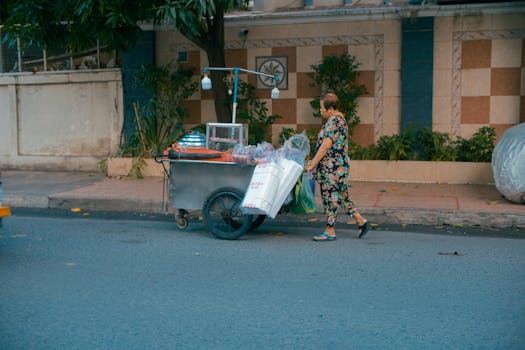Cambodia’s bustling streets are filled with tempting aromas and vibrant colors from street vendors offering a variety of delicious foods. While these dishes provide an authentic taste of local culture, it’s essential to prioritize hygiene when indulging. Follow these detailed tips to enjoy Cambodia’s street food safely and avoid poorly washed utensils.

Cambodia Street Food Safety: Tips to Avoid Poorly Washed Utensils
Why Hygiene Matters When Enjoying Street Food
Street food in Cambodia is an integral part of the local culture and provides a unique culinary experience. However, the hygiene standards can vary greatly between vendors. Poor sanitation, including improperly washed utensils, can lead to foodborne illnesses. By taking a few precautions, you can savor the flavors of Cambodia without compromising your health.
1. Use Your Own Utensils
Bringing your own utensils is one of the simplest ways to ensure cleanliness. Using personal or disposable utensils reduces the risk of exposure to improperly washed ones. If you’re using disposable utensils, make sure to rinse them with clean bottled water before use.
Key Points:
- Carry travel-friendly cutlery or chopsticks.
- Avoid using utensils provided by vendors if their washing facilities look questionable.
- Disposable utensils are a safer option but should still be cleaned before use.
2. Choose Busy Vendors
Popular street food stalls with high foot traffic are often a safer choice. Vendors serving a steady stream of customers tend to prepare food frequently, ensuring freshness and reducing the likelihood of contamination.
Key Points:
- Observe which stalls are busy with locals.
- High turnover ensures freshly cooked food.
- Vendors with clean and organized stalls are usually more reliable.
3. Observe the Cooking Process
Watch how your food is prepared. Vendors who follow basic hygiene practices, such as wearing gloves and using clean utensils, are a better choice.
Key Points:
- Check if the vendor wears gloves while handling food.
- Look for clean cooking surfaces and utensils.
- Avoid stalls where raw and cooked foods are handled together without proper separation.
4. Be Cautious with Water and Ice
Contaminated water is a common source of illness. Stick to bottled water for drinking and avoid ice in your beverages unless you’re certain of its source.
Key Points:
- Drink sealed bottled water only.
- Avoid ice made from tap water.
- Opt for beverages served without ice whenever possible.
5. Check Food Temperatures
Hot food is generally safer than cold food. Ensure that your dish is served piping hot and that meats and seafood are fully cooked.
Key Points:
- Avoid dishes that have been sitting out for long periods.
- Ensure meats and seafood are cooked thoroughly.
- Food should be steaming hot when served.
6. Inspect Washing Facilities
Observe how utensils and dishes are washed. Vendors who reuse water or lack proper washing facilities may increase the risk of contamination.
Key Points:
- Avoid stalls where utensils are washed in reused or stagnant water.
- Look for vendors with access to running water for cleaning.
- Prefer vendors who use disposable serving ware.
7. Check Ingredient Freshness
Fresh ingredients are crucial for food safety. Pay attention to the appearance and smell of raw ingredients at the stall.
Key Points:
- Avoid stalls using ingredients that look stale or discolored.
- Seafood and meats should have a fresh smell.
- Vegetables should look crisp and vibrant.
8. Hand Washing Facilities
Vendors with access to handwashing stations are likely to maintain better hygiene.
Key Points:
- Observe whether vendors wash their hands regularly.
- Vendors with visible handwashing facilities are a safer choice.
- Carry hand sanitizer to use before eating.
9. Avoid Raw and Undercooked Foods
Stick to fully cooked dishes to reduce the risk of foodborne illnesses. Avoid raw seafood, undercooked meats, and dishes with unpeeled fruits or vegetables.
Key Points:
- Opt for grilled, fried, or boiled dishes.
- Avoid salads or dishes with raw garnishes.
- Always peel fruits before eating.
10. Practice Personal Hygiene
Your own hygiene practices can make a significant difference in food safety. Wash your hands thoroughly before and after meals.
Key Points:
- Use hand sanitizer frequently.
- Avoid touching your face while eating.
- Dispose of waste properly to keep the environment clean.
By following these tips, you can enjoy Cambodia’s vibrant street food scene while minimizing health risks. From choosing busy vendors to carrying your own utensils, a little preparation goes a long way in ensuring a safe and enjoyable culinary adventure. Cambodia Street Food Safety is essential for travelers seeking authentic yet hygienic culinary experiences.
For additional insights into budget-friendly and safe travel destinations in Asia, including Cambodia, refer to this article: Top 5 Cheapest and Safest Asian Countries to Visit in 2025 – A Budget Traveler’s Guide. It offers valuable tips and recommendations for exploring the region economically and securely.